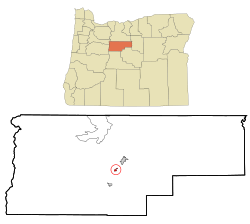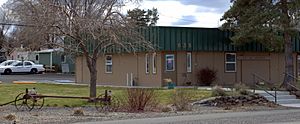Metolius, Oregon facts for kids
Quick facts for kids
Metolius, Oregon
|
|
|---|---|

City of Metolius Welcome Sign
|
|

Location in Oregon
|
|
| Country | United States |
| State | Oregon |
| County | Jefferson |
| Incorporated | 1913 |
| Area | |
| • Total | 0.48 sq mi (1.24 km2) |
| • Land | 0.48 sq mi (1.24 km2) |
| • Water | 0.00 sq mi (0.00 km2) |
| Elevation | 2,530 ft (771.1 m) |
| Population
(2020)
|
|
| • Total | 978 |
| • Density | 2,046.03/sq mi (789.71/km2) |
| Time zone | UTC-8 (Pacific) |
| • Summer (DST) | UTC-7 (Pacific) |
| ZIP code |
97741
|
| Area code(s) | 458 and 541 |
| FIPS code | 41-47750 |
| GNIS feature ID | 1146116 |
Metolius is a small city located in Jefferson County, Oregon, in the United States. It gets its name from the nearby Metolius River, which flows into the Deschutes River. The word "Metolius" comes from the Warm Springs or Sahaptin language. It means "white salmon," referring to a type of light-colored Chinook salmon. In 2020, about 978 people lived in Metolius.
Contents
Exploring Metolius: Location and Climate
Metolius is a small city that covers about 0.48 square miles (1.24 square kilometers) of land. It does not have any water area.
Understanding Metolius's Weather Patterns
Metolius has a climate known as a "warm-summer Mediterranean climate." This means it has warm and dry summers. The average monthly temperature does not go above 71.6°F (22°C).
A Look Back: The History of Metolius
Metolius was first settled in the early 1900s. The oldest records about the town date back to 1903 and were written in German.
The Railroad Era and Early Growth
In February 1911, the Oregon Trunk Railroad built a depot, turntable, and roundhouse in Metolius. This connected the town to Bend, Oregon. Trains back then needed water often, so Metolius became a key stop for servicing them.
Electricity came to Metolius in 1912 from a small dam. A high school and a grade school were built in 1913. The town grew quickly during the war years. By 1917, over 1,700 people lived there. Metolius had two banks, two newspapers, a flour mill, hotels, and general stores. It was also a busy railroad maintenance center.
Challenges and Decline in Metolius
As train technology improved, fewer maintenance stops were needed. The railroad shop in Metolius closed down. Without the railroad, the town's population started to shrink. A big fire in the 1920s destroyed most of the buildings downtown.
From 1924 to 1926, a drought caused many farmers to lose their farms. The Great Depression made things even harder for the town. By 1945, only about 45 people lived in Metolius.
Revival Through Irrigation and Agriculture
Before the 1940s, farming in the area relied only on rain. Then, a large irrigation project brought water from the Deschutes River. This helped farming greatly, and the town began to grow again. Water reached the farms through a big system of canals.
Farmers could now grow large crops like mint, potatoes, and hay. By 1960, over 3,000 train cars of fresh potatoes were shipped from the area each year. There were four big packing sheds that stored potatoes and loaded them onto trains. A factory that made frozen French fries also employed many people.
However, in 1968, a potato disease ended large-scale potato farming. In 1973, the railroad closed its depot in Metolius. By 1990, most mint production also stopped due to a plant disease. Today, farming around Metolius is not as big as it once was.
Growth of Metolius Elementary School
Metolius Elementary School started in the old 1913 high school building in 1950. A new gym and two classrooms were added. Four more classrooms were built in 1955. This was to teach the children of new farm workers and people building dams on the Deschutes River.
Around 1963, the old high school building was taken down. The elementary school was expanded again with an office, a library, and two more classrooms. Its most recent expansion was in 2000. Six new classrooms and a large modern library were added then.
A Diverse Community in Metolius
In the 1950s, the first Spanish-speaking families began to move to Metolius. They came for farm work, like hoeing, watering, and harvesting crops. Many also worked in the potato sheds. Mills that used scrap wood from lumber operations hired more Spanish-speaking workers from Mexico. Today, over 50% of the students at Metolius Elementary speak Spanish at home.
Around 1970, a fire at the city's Post Office led to Metolius losing its own ZIP code. It then shared the ZIP code of nearby Madras. However, in late 2003, city leaders worked with U.S. Representative Greg Walden to get their ZIP code back. Metolius mostly serves as a "bedroom community" for Madras and other larger towns up to 40 miles (64 km) away. A prison is being built in Madras, and new homes are being built for its workers.
Who Lives in Metolius? Population Facts
| Historical population | |||
|---|---|---|---|
| Census | Pop. | %± | |
| 1920 | 94 | — | |
| 1930 | 38 | −59.6% | |
| 1940 | 40 | 5.3% | |
| 1950 | 157 | 292.5% | |
| 1960 | 270 | 72.0% | |
| 1970 | 270 | 0.0% | |
| 1980 | 451 | 67.0% | |
| 1990 | 450 | −0.2% | |
| 2000 | 635 | 41.1% | |
| 2010 | 710 | 11.8% | |
| 2020 | 978 | 37.7% | |
| source: | |||
Metolius Population in 2010
In 2010, the city of Metolius had 710 people living in 275 households. There were 190 families. The city had about 1,479 people per square mile (571 per square kilometer). There were 297 housing units, with about 619 housing units per square mile (239 per square kilometer).
Most people in Metolius were White (75.6%). Other groups included African American (1.0%), Native American (3.8%), and Asian (0.6%). About 14.8% were from other races, and 4.1% were from two or more races. People of Hispanic or Latino background made up 23.7% of the population.
Out of 275 households, 37.8% had children under 18 living with them. About 49.5% were married couples. Around 13.8% had a female head of household with no husband, and 5.8% had a male head of household with no wife. About 30.9% were not families.
About 23.6% of all households were single individuals. Around 8% had someone living alone who was 65 years or older. The average household had 2.58 people, and the average family had 3.03 people.
The average age in Metolius was 38.6 years. About 26.2% of residents were under 18. About 9.7% were 65 years or older. The population was evenly split, with 50.0% male and 50.0% female.
See also
 In Spanish: Metolius para niños
In Spanish: Metolius para niños


